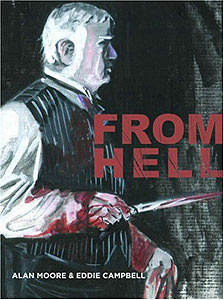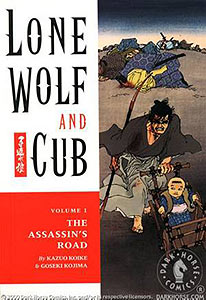Travel Advice for a Journey Into Comic Books
Published on January 30th, 2009 in: Books, Comics, Issues |The Violent but Worthy: From Hell and Lone Wolf and Cub
Alan Moore makes another appearance with From Hell, a collaboration with artist Eddie Campbell, which was published in ten issues from 1991 to 1996. It presents Moore’s look at Jack the Ripper and the times in which the murders occurred, with a heavy dose of metaphysics applied. Moore begins with Stephen Knight’s theory that the murders were committed in order to preserve a royal secret, and then steps into his own ideas about women, time, and the passing of the 19th century into the 20th. Although the concepts may be a little different from those of the general comic population, they are quite interesting to read, and are well written.

Campbell’s art was unsettling for me at first, as it is raw and unpolished; the lettering is clear but shaky. It is well in keeping with the tone of From Hell, though, as it echoes the tension and madness in the characters and the times, as well as the unsettling nature of the crimes depicted. This is in no way a book for younger readers, as it is unflinching in its depiction of sex and murder, not to mention the sometimes-esoteric nature of the prose. For the mature audience, it’s a strong look at London in the late 1800s during the Whitechapel murders, and the forces that gave birth to them.
This was another Moore comic that was made into a movie, although most of the metaphysical is sacrificed in favor of a straight murder mystery, even though the comic makes no attempt to disguise the identity of the killer. From Hell is available in a single collected volume.
Lone Wolf and Cub is the only manga (Japanese comic book) that I’ve read, and it impressed the hell out of me. After reading Dave Sim’s Cerebus, which is the longest-running English-language comic book series ever by a single writer and art team at 6,000 pages, I discovered that the longest-running comic in any language was Lone Wolf and Cub and decided to investigate.

Writer Kazuo Koike and artist Goseki Kojima began the story in 1970 in a weekly magazine and ended six years later after more than 8,000 pages of work. It tells the story of Ogami Ittō, a shogun’s executioner who was framed for a crime he didn’t commit: having the shogun’s icon in his family shrine, an act which represented a wish for the leader’s death. But the tragedy comes from the fact that the “crime” was discovered while the shogun’s men were investigating the murder of Ittō’s wife. This, of course, was a deliberately planned act to both punish and humiliate Ittō. As a result, he and his surviving son Daigorō take to the countryside, selling Ittō’s services as an assassin. The series spawned more than seven popular films in Japan, and continues to inspire.
There are very strong emotions in Lone Wolf, seen in Ittō’s devotion to honor and respect, as well as the bond between father and son that Ittō and Daigorō share. But in addition to the restrained passion and love, there is plenty of sex and violence. The sex scenes are few and far between, but a large percentage of the 8,000 pages are devoted to Ittō’s battles with anywhere from one to hundreds of enemy warriors. Ittō’s skill is so great, and his sword is so strong that he seems to be able to defeat anything that opposes him. His son, though a newborn at the start of the epic, is equally strong and stoic, and provides a suitable companion for the great warrior. They travel together across Japan, though powerful forces ally against them, relying only on Ittō’s cunning and skill to keep them alive.
I was drawn into the story by the action, but through the careful development of the warrior and his child, I became increasingly involved with the pair. By the end of the 28th and final volume, I was a wreck, but a grateful wreck. Like Cerebus, it’s a long journey, but worth the effort. Lone Wolf and Cub has been released in English by Dark Horse comics in 28 manga-sized (4″ x 6″) volumes.
I’ve been reading comics since they cost a quarter, but only recently have they been allowed to develop as unique forms of art: stories that push the boundaries of what’s expected and illustration that breaks out of ordinary constraints. There’s a lot to choose from out there, and not all of it is going to mesh with your idea of what’s “good” or “interesting.” With so many books in print, it’s hard to get an idea of what different titles are about, but I’ve tried to give you a run down of the ones that have made the biggest impressions on me, and maybe you’ll like them.
If you do, look for other titles by the authors and/or artists, and then check out people who are mentioned in the same paragraph as them. It’s kind of like crossing a river by jumping from one rock to another, and once you’ve gotten some experience at it, maybe you can provide some guidance to the next traveler. Have a nice trip.
Click to read more about. . .
The Classics: Watchmenand The Sandman
The Humorous: Red Rocket 7 and Transmetropolitan
4 Responses to “Travel Advice for a Journey Into Comic Books”
February 13th, 2009 at 3:35 pm
This? Is AWESOME. I’d love to do a followup to this piece just so I could gush about SCOTT PILGRIM and PHONOGRAM… maybe someday…
February 13th, 2009 at 3:36 pm
Someday can be whenever you want!!
LLM
June 9th, 2009 at 2:42 pm
Nice article, Christian. Heard of most of these but didn’t know much about them. I’ll definitely have to check out Transmet and Lone Wolf and Cub, at the very least (and also, as I’m sure Jemiah would suggest, Scott Pilgrim).
Meanwhile, might I humbly offer of my own recommendations: Y-The Last Man, and 100 Bullets. Each is awesome in its own ways.
June 9th, 2009 at 3:13 pm
Reay, yes – I have read some of Y The Last Man, and loved it. 100 Bullets I’ve heard a lot of good things about, too. Thanks!
Time limit is exhausted. Please reload the CAPTCHA.